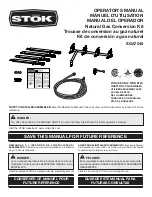
10
achieved. Curing of paints and parts will
produce an odor only on first use.
WARNING
All cleaning and maintenance should only be done when the
appliance is cool and with the fuel supply turned off at the
LP cylinder. DO NOT clean any part in a self-cleaning oven.
The extreme heat will damage the finish.
Cleaning The Burner
NOTE: Spiders and small insects can spin webs
and build nests inside the burner. This especially
occurs in late summer and fall before frost when
spiders are most active. These nests can obstruct
gas flow and cause a fire in and around the burner
and orifice. Such a fire can cause operator injury
and serious damage to the appliance. To help
prevent a blockage and ensure full heat output,
clean and inspect burner tube often (once or twice
a month). NOTE: Water or air pressure may not
clear a spider web.
Steps for cleaning the Burner:
1. Remove orifice/valve from burner.
2. Look inside the burner tube for nests, webs, or
mud.
3. To remove the above obstructions, use an
accessory flexible venturi brush or bend a small
hook on one end of a long flexible wire or use an
air hose.
4. Inspect and clean the burner if needed.
5. Reattach orifice/valve to burner.
Cleaning and Maintenance
Correct care and maintenance will keep your
appliance operating smoothly. Clean regularly as
determined by the amount of use. NOTE: Clean
the entire appliance each year and tighten all
hardware on a regular basis (1-2 times a year or
more depending on usage). Cleaning should be
done where detergents won’t harm patio, lawn, or
the like.
Suggested Cleaning Materials
• Mild dish washing liquid detergent
• Wire brush
• Nylon cleaning pad
• Hot water
• Paper clip
• Soft brass bristled brush
Component Cleaning:
• BURNER: Wire brush loose corrosion from
burner exterior. Clean clogged gas port holes
with an opened paper clip. Replace corroded or
damaged burners that would emit excess gas.
• COOKING SURFACES, POTS AND PANS: Clean the
cooking surface with soapy water and a nylon
cleaning pad.
• After appliance has cooled, wipe areas where
paint and finish have burned off to minimize
rusting.
Griddle User Guide
Camp Chef True-Seasoned Finish means your
griddle is ready to cook on and with the proper
care will get better with use. Its natural non-stick
surface is great for grilling or frying breakfast,
lunch, or dinner.
WARNING:
Never heat griddle on high. This can
cause griddle to over-heat and warp. Low to
medium will provide all the heat needed to cook
with. Never leave unattended.
Preheating Instructions
Proper pre-heating will get the best performance
out of your griddle. Adjust your heat to Medium
or Med-Low heat setting for approximately 5
minutes. This should produce a griddle surface
temperature of 350°-400° F. Now turn heat to
med-low to low for 2-3 minutes for uniform heat.
You are ready to cook.
Temperature Management
Manage heat from low to medium to maintain
desired heat for the cooking conditions. Consider
what the weather conditions are like. Cold and
windy? You’ll need more heat. What’s being
cooked and how much of it? Considering these
elements will help you cook better and get the
most of out your griddle.
Using a Thermometer
Prior to lighting, position thermometer clip so that
at least 1/2” of thermometer tip is submerged in
oil. Reposition thermometer as necessary to cook.
Continue to use thermometer until burner is turned
off.
If Frying:
• Follow instructions provided by the appliance
manufacturer.
• When cooking with oil or grease, a thermometer
must be used.
• Introduction of water from any source into the
cooking oil or grease may cause overflow and
severe burns from hot oil and water splatter.
When frying with oil and grease, all food
products MUST be completely thawed and towel
dried to remove water before being immersed in
the fryer.
• Be sure thermometer is in good working
condition. To check the thermometer, insert it
into a pot of boiling water and ensuring that it
registers approximately 212°F ± 20°F (100°C
± 10°C). If it does not function properly, obtain
a replacement thermometer specified by the
manufacturer before using the appliance.
• When frying with oil or grease, do not use a pot
deeper than 6”(132mm)
• Do not over fill the pot with cooking liquid.
Never fill appliance more than half full of
cooking liquid or past the maximum fill line (a
permanent marking on fryer).
• If cooking liquid has spilled and ignited, do not
attempt to extinguish with water. Immediately
turn gas supply OFF at the supply cylinder and:
1. Extinguish flames using a BC type fire
extinguisher as recommended by the fryer
manufacturer; or
2. Smother flames with dirt or sand.
3. In case there is a fire, call the local fire
department or dial 911.
4. To avoid accidental burns from burner
flame or hot cooking liquid, turn the burner
off before inserting or removing food from
the fryer.
• When removing food from the fryer, be
sure to avoid burns from hot cooking liquid
drippings.

































